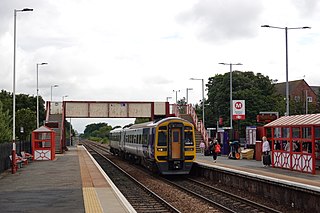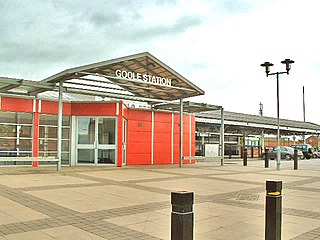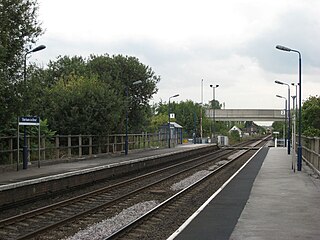
The Dearne Valley line is the name given to a railway line in the north of England running from York to Sheffield via Pontefract Baghill and Moorthorpe. The route was built over several years and consists of lines built by several railway companies.

The Pontefract line is one of the rail services in the West Yorkshire Metro area of northern England. The service is operated by Northern, and links Wakefield and Leeds with Goole via Pontefract. The Metro timetable for the line also includes services operated as the Dearne Valley line between York and Sheffield via Pontefract.

Goole railway station is a railway station in the port town of Goole on the Hull and Doncaster Branch in the East Riding of Yorkshire, England.

Pontefract Monkhill railway station is the busiest station in the town of Pontefract, West Yorkshire, England. The station is on the Pontefract Line managed by Northern but is also served by Grand Central and is 14 miles (23 km) south east of Leeds.

Knottingley railway station serves the town of Knottingley in West Yorkshire, England. It lies on the Pontefract Line, operated by Northern, and is 16 miles (26 km) south east of Leeds railway station.

Selby railway station is a Grade II listed station which serves the market town of Selby in North Yorkshire, England. The original terminus station was opened in 1834 for the Leeds and Selby Railway. The Hull and Selby Railway extended the line in 1840 and a new station was built, with the old station becoming a goods shed. The station was rebuilt in 1873 and 1891; the 1891 rebuilding was required due to the replacement of the swing bridge over the River Ouse at the same time.

South Milford railway station serves the villages of South Milford and Sherburn in Elmet in North Yorkshire, England. It lies on the Selby Line 13 miles (21 km) east of Leeds.

Church Fenton railway station serves the village of Church Fenton in North Yorkshire, England. It is situated where the Cross Country Route from Leeds to York meets the Dearne Valley line from Sheffield to York, just under 10.75 miles (17 km) from York.

Sherburn-in-Elmet railway station serves the town of Sherburn in Elmet in North Yorkshire, England. The station is located approximately 1 mile (1.6 km) from the town centre.

South Milford is a village and civil parish in the county of North Yorkshire, England. The civil parish includes the hamlet of Lumby, located south-west of the main village.

Gilberdyke railway station is a railway station that serves the village of Gilberdyke in the East Riding of Yorkshire, England. It was opened in 1840 by the Hull and Selby Railway, and until 1974 it was known as Staddlethorpe station. Today it is operated by the Northern train operating company. Situated 17 miles (27 km) west of Hull, it is the junction for the lines to Selby and to Goole and Doncaster.
The Leeds and Selby Railway was an early British railway company and first mainline railway within Yorkshire. It was opened in 1834.

The York and North Midland Railway (Y&NMR) was an English railway company that opened in 1839 connecting York with the Leeds and Selby Railway, and in 1840 extended this line to meet the North Midland Railway at Normanton near Leeds. Its first chairman was the railway financier George Hudson, who had been called the railway king.

Selby coalfield was a large-scale deep underground mine complex based around Selby, North Yorkshire, England, with pitheads at Wistow Mine, Stillingfleet Mine, Riccall Mine, North Selby Mine, Whitemoor Mine and at Gascoigne Wood Mine. All coal was brought to the surface and treated at Gascoigne Wood before being distributed by rail. The primary purpose of the pit was to supply coal for electrical power generation; much of it was used in the nearby Aire valley power stations.
The Hull and Doncaster Branch is a secondary main railway line in England, connecting Kingston upon Hull to South Yorkshire and beyond via a branch from the Selby Line near Gilberdyke to a connection to the Doncaster–Barnetby line at a junction near Thorne 8 miles north-east of Doncaster.

Knottingley TMD was a traction maintenance depot located in Knottingley, West Yorkshire, England. The depot was situated on the Pontefract Line and was near Knottingley station. It opened in 1967 to maintain the locomotives and hopper wagons for a planned 75 Merry-go-round trains a day, expected to use the Wakefield and Goole line.

Leeds Midland Road depot is a locomotive and rolling stock maintenance facility located in Leeds, West Yorkshire, England. The site is located a few miles to the south-east of Leeds station on the line between Leeds and Castleford. Owned and operated by Freightliner, it is the heavy maintenance facility for its diesel and electric locomotives and wagon fleet.

Basford Hall Yard is a railway marshalling yard near the town of Crewe, Cheshire, England. The yard, which is 0.93 miles (1.5 km) south of Crewe railway station, was opened in 1901 by the London and North Western Railway (LNWR). Initially used to marshal trains, the site now acts as a hub mainly for Freightliner intermodal trains, but also houses departmental sidings as used by Freightliner Heavy Haul, and other operators. For a period in the 1930s, Basford Hall was the busiest marshalling yard in Europe, handling between 28,000 and 47,000 wagons every week.

Monk Fryston railway station was a railway station serving the village of Monk Fryston in North Yorkshire, England. Previously, Milford Junction and Old Junction served as an interchange between the Leeds and Selby and the York and North Midland Lines, however when they closed in the early 1900s, Monk Fryston was opened to cover for this loss of interchange. Though the station had four tracks through it, it only ever had two platforms. The station closed to passengers in 1959, and then completely in 1964.
Gascoigne Wood Junction railway station was a railway station near Sherburn-in-Elmet in North Yorkshire, England. It was originally opened as a junction station, enabling transfers for passengers between trains. It was later a private halt station for the staff who worked at the Gascoigne Wood marshalling yard. It opened in 1839, and was closed, renamed and re-opened several times before closing completely in 1959. The station was 14 miles (23 km) from Leeds New Station, and 6 miles (9.7 km) from Selby.



















